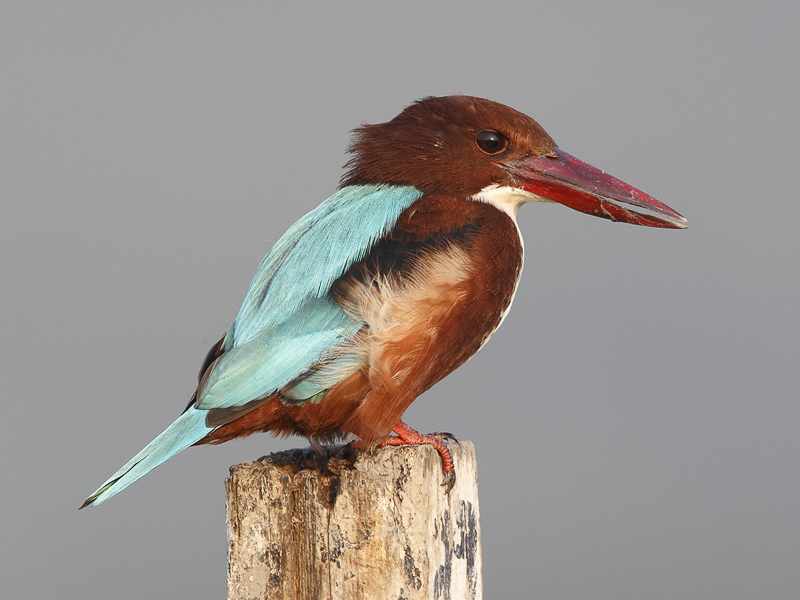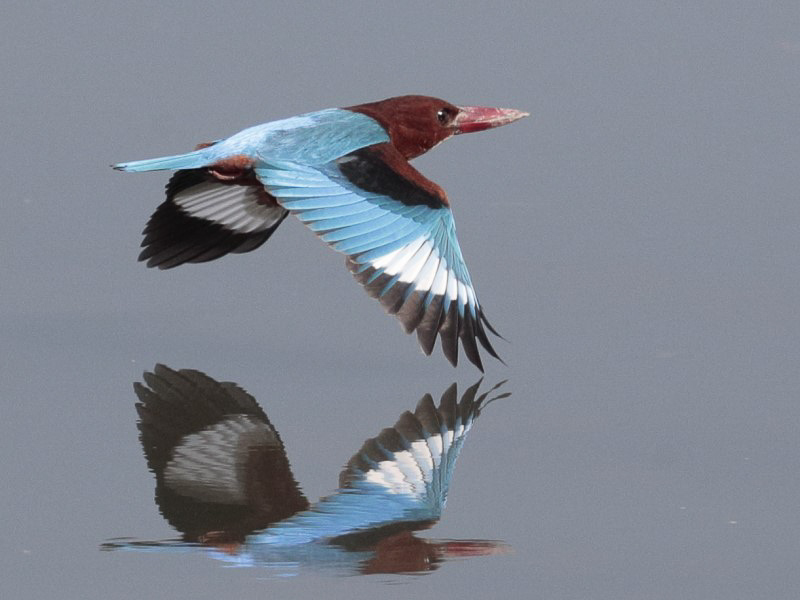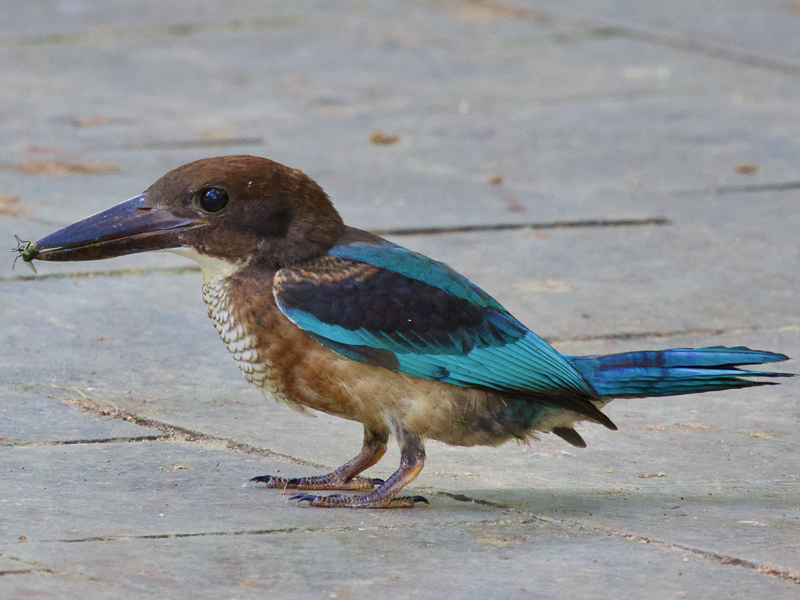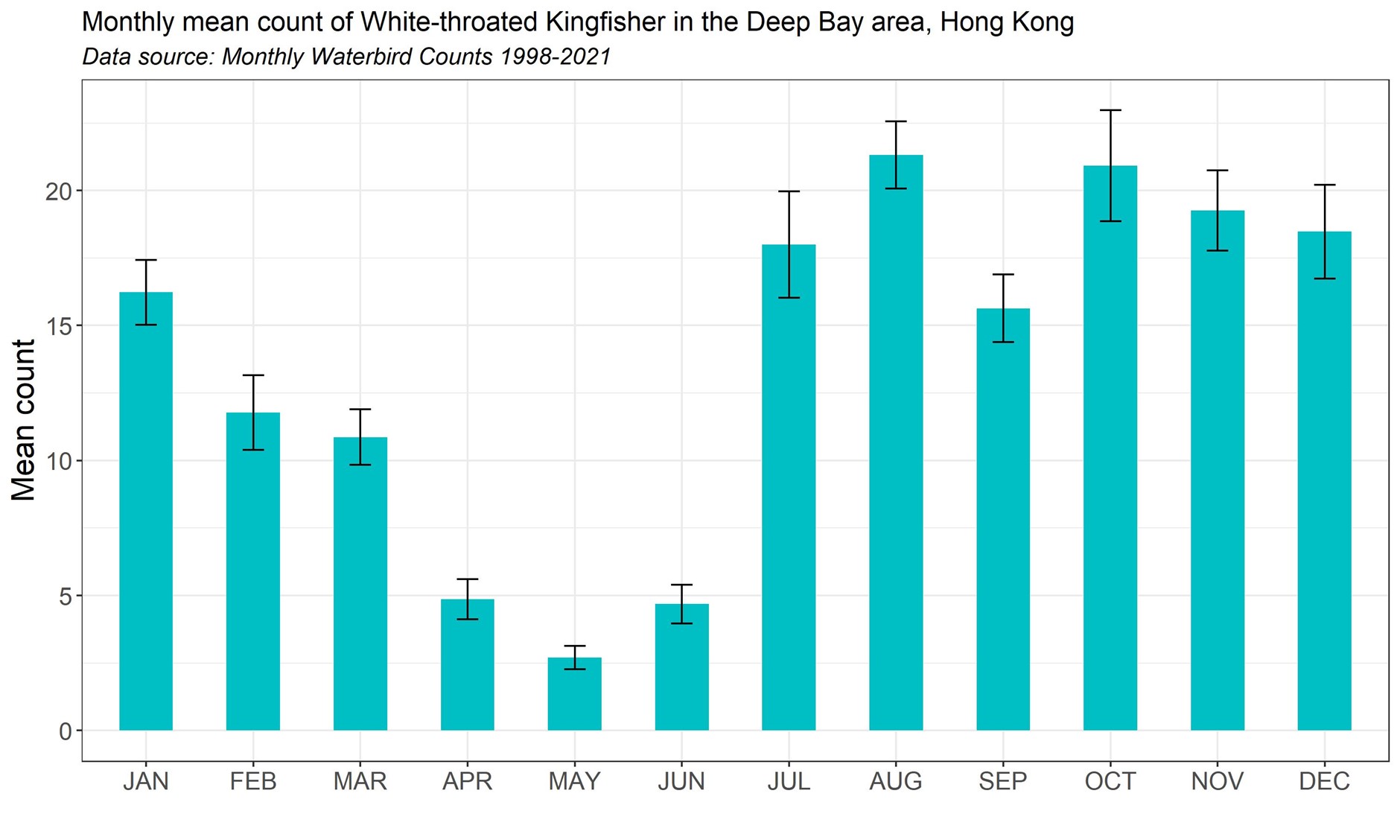White-throated Kingfisher Halcyon smyrnensis 白胸翡翠
Category I. Present all year with numbers highest in the second half. Much declined, particularly in the breeding season. Occurs mainly in Deep Bay wetlands in the winter, but in mixed shrubland and farmland habitats in the breeding season.
IDENTIFICATION

Oct. 2011, Martin Hale. Adult.
26-29 cm. Large, brightly coloured and generally unmistakeable large-billed kingfisher. Adults have a deep red bill, deep orange-brown head, lesser coverts and flanks, a white throat, chest centre and belly, and pale turquoise upperparts and tail.

Oct. 2017, John and Jemi Holmes. Adult.
In flight shows a large white patch at the base of the primaries that contrasts with dark wing tips and powder blue secondaries.

Jul. 2023, Bob Thompson. Juvenile.
Juveniles have a much duller head, body and bill compared to adults, and the chest feathers are scaled narrowly with dark.
VOCALISATIONS
The commonly heard call comes from birds in flight, a harsh and loud ‘kee-kee-kyee-kyee…’ that is similar to Black-capped Kingfisher but is slightly higher in both pace and pitch.
In the breeding season, a high-pitched trilling laugh may be heard.
DISTRIBUTION & HABITAT PREFERENCE
White-throated Kingfisher is recorded mainly on the coast in autumn and winter and inland in spring and summer, a seasonal shift that is especially marked in Deep Bay.
In autumn and winter it is widespread and is reported mainly from coastal mudflat and mangrove sites, though it also occurs inland on fish ponds, wet agricultural areas, golf courses and even city parks. In summer, however, it is more often found inland, on hillsides and in drier, better-wooded areas, and on offshore islands, though it has bred at a few coastal sites.
There are very few breeding season records at Mai Po and Tsim Bei Tsui. Whether this can be explained in terms of a lack of suitable nest-sites (though this seems unlikely at Tsim Bei Tsui), seasonal dietary changes or other factors is not known.
The percentage of occupied 1km squares fell markedly from 21.9% to 5.4% between the breeding bird surveys of 1993-96 and 2016-19. While part of this may be accounted for by a difference in methodology, it is undoubtedly the case that White-throated Kingfisher is significantly less widespread as a breeding species than formerly. The decline has occurred throughout HK.
This decline was echoed in the winter atlas surveys of 2001-05 and 2016-19 which saw a fall from 8.2% to 4.4%. Again, the decline occurred through much of HK.
OCCURRENCE
White-throated Kingfisher is recorded throughout the year. In the Deep Bay area (Figure 1) numbers are lowest in April, May and June during the breeding season, as many birds are inland. July and August sees a sharp rise, presumably due to post-breeding dispersal and return to wintering areas. It is unclear what the dip in numbers in September entails (though it is possible it signals a decline after a migratory peak), but numbers are relatively high again in the final three months of the year. A decline then ensues during January to March, which may reflect winter period mortality followed by withdrawal to the breeding areas.
The highest count is 19 logged in the Deep Bay area during a co-ordinated count on 20 December 1998. This compares with high counts at much smaller individual sites of 18 at the former Ping Shan marshes on 14 November 1966 and 14 at Mai Po on 5 October 2005.
The literature strongly suggests that a decline in the summer population has occurred since the 1930s. Having first been recorded in HK by Swinhoe (1861), this species was described by Vaughan and Jones (1913) as predominantly a summer visitor, with wintering numbers supplemented by individuals arriving in the third week of March to breed in the hills. Likewise, in the 1930s, it was said to be present in summer ‘in any part of Hong Kong from the top of Victoria Peak to sea-level’ with smaller numbers remaining at lower altitudes in winter (Herklots 1934). Clearly, it can no longer be regarded in those terms today.
This species was commercially exploited in the manufacture of ‘kingfisher enamel’ in which its feathers were mounted behind glass (Kershaw 1904, Vaughan and Jones 1913) and in the treatment of gout (Webster 1975). It was imported into HK from China during 1965-1980 (Melville 1982).
There are no obvious explanations for the recent decline. It does not appear to be a long-distance migrant, and so the reasons are considered to relate to changes arising in HK. The breeding season requirement for a mosaic of shrubland, farmland and the interface of these habitats usually at the edge of hills is similar to the requirements of other species that have declined here such as Long-tailed Shrike and Sooty-headed Bulbul, and this may be relevant.
BREEDING
Nothing significant has been added to our knowledge of nesting habits in HK since those described by Vaughan and Jones (1913). They described migrants repairing to the hills or water-worn nullahs soon after arrival to create, preferably, new nest holes, though not all the time. The nest hole is described as 18 inches to two feet deep with an enlarged bare chamber at the end in which the eggs are laid. Gradually, inedible parts of prey items build up around the nest as they are disgorged.
Since 1958, nesting has been noted in May, occasionally from early April, and recently-fledged young have been seen in June and July.
BEHAVIOUR, FORAGING & DIET
The few observations of food since 1958 suggest a seasonal change in diet, as does the difference in habitat preference. Birds have been recorded eating fish and crustaceans in the non-breeding season and invertebrates, lizards and snakes in the breeding season. A nesting chamber with eggs examined by Vaughan and Jones (1913) contained a pile of insect and crab remains as well as the bones of lizards and small reptiles.
In the breeding season single birds and pairs fly round at some height uttering a trilling laugh (see above), occasionally for as long as an hour (Vaughan and Jones 1913).
RANGE & SYSTEMATICS
Resident from the eastern Mediterranean through southwest Asia and the Indian subcontinent to Indochina, south China and southeast Asia as far as Sumatra (Woodall and Kirwan 2020). In China, resident in much of south China south from the Chang Jiang (Yangtze River) (Liu and Chen 2020).
CONSERVATION STATUS
IUCN: Least Concern. Population trend stable.
Figure 1.

Herklots, G. A. C. (1934). The birds of Hong Kong. Part XV. Family Alcedinidae, the kingfishers. Hong Kong Naturalist 5: 77-79.
Liu, Y. and Y. H. Chen (eds) (2020). The CNG Field Guide to the Birds of China (in Chinese). Hunan Science and Technology Publication House, Changsha.
Melville, D. S. (1982). A preliminary survey of the bird trade in Hong Kong. Hong Kong Bird Report 1980: 55-102.
Swinhoe, R. (1861). Notes on the ornithology of Hong Kong, Macao and Canton, made during the latter end of February, March, April and the beginning of May 1860. Ibis 1861: 23-57.
Vaughan, R. E. and K. H. Jones (1913). The birds of Hong Kong, Macao and the West River or Si Kiang in South-East China, with special reference to their nidification and seasonal movements. Ibis 1913: 17-76, 163-201, 351-384.
Webster, M. A. (1975). Hong Kong’s trade in wildlife. Hong Kong Bird Report 1974: 54-61.
Woodall, P. F. and G. M. Kirwan (2020). White-throated Kingfisher (Halcyon smyrnensis), version 1.0. In Birds of the World (J. del Hoyo, A. Elliott, J. Sargatal, D. A. Christie, and E. de Juana, Editors). Cornell Lab of Ornithology, Ithaca, NY, USA. https://doi.org/10.2173/bow.whtkin2.01

